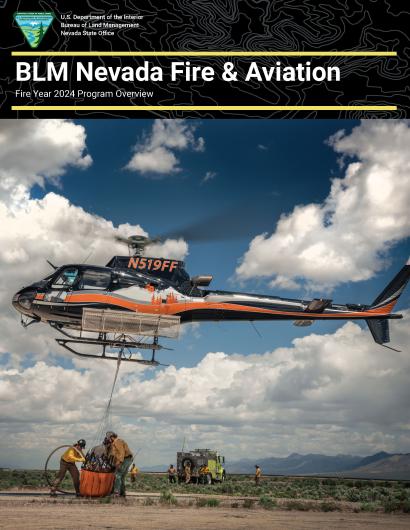Nevada Fire and Aviation
BLM Nevada Fire and Aviation manages approximately 48 million acres of public lands in Nevada. With the exception of Alaska, BLM Nevada has the second largest Fire and Aviation program in the Bureau of Land Management. The BLM Nevada State Office is located in Reno, along with 6 District Offices located in Elko, Winnemucca, Carson City, Ely, Las Vegas, and Battle Mountain.
BLM Nevada Firefighting Resources on average include the following:
- 7 Single Engine Air Tankers
- 3 Helicopters, positioned in Las Vegas and Elko (with the ability to staff 6 helicopters)
- 2 Air attack Aircraft for aerial detection and fire air traffic control
- 2 Hotshot Crews: Silver State Hot Shots (Carson City) and Ruby Mountain Hot Shots (Elko)
- 1 Type 2 Initial Attack Crew (Vegas Valley Crew)
- 51 Fire Engines
- 6 Dozers (Winnemucca, Battle Mountain, and Elko)
- Additional aircraft and equipment can be brought to Nevada based upon heightened fire danger and ongoing wildfires
Other programs within Fire and Aviation include: Fire Prevention and Mitigation, Hazardous Fuels, and Emergency Stabilization and Rehabilitation (ES&R).
The Fire Prevention and Mitigation program is responsible for coordinating with the public on fire prevention, i.e. the Smokey Bear campaign, and establishing mitigation measures for home owners and the district in the event of a wildfire. Unauthorized fires also known as Trespass Fires, are fires tied to human activity. Trespass fires on BLM public lands are investigated to determine origin, cause, and responsibility.
The Hazardous Fuels program implements fuels management projects to reduce hazardous fuels on public lands which help protect valuable natural resources and create a safer environment for the public and wildland firefighters in the event of a wildfire.
Emergency Stabilization and Rehabilitation is done after a wildfire burns through an area. Primary goals include soil stabilization, erosion control, and prevention of invasive plant species from becoming established. Emergency stabilization is defined as “Planned actions to stabilize and prevent unacceptable degradation to natural and cultural resources, to minimize threats to life and property resulting from the effects of a fire, or to repair/replace/construct physical improvements necessary to prevent degradation of land or resources. Emergency Stabilization actions must be taken within one year following containment of a wildland fire.” Burned Area Rehabilitation is defined as “Efforts undertaken within three years of containment of a wildland fire to repair or improve fire-damaged lands unlikely to recover naturally to management approved conditions, or to repair or replace minor facilities damaged by fire.”
Interagency Cooperation
BLM Nevada, the United State Forest Service Humboldt Toiyabe National Forest, Nevada Division of Forestry, Counties and local Fire Departments are responsible for the suppression of wildland fires throughout the state. We all work cooperatively to provide the most successful response to wildland fire and hazardous fuels reduction; this includes sharing of resources, combined interagency dispatch centers, the utilization of closest forces regardless of jurisdiction, and partnering in providing training to of all Nevada fire suppression forces.
All Federal partners in Nevada and Nevada Division of Forestry have entered into a Statewide Master Agreement that covers a range of fire management and fire suppression actions. This is also the instrument that is used to exchange funds for suppression expenditures.
BLM Nevada Sage-grouse Habitat Protection from, and Rehabilitation after, Wildfire
- DOI Secretarial Order 3336 issued on 01/05/2015
- The DOI and the BLM have identified Greater Sage-grouse habitat as the highest natural resource protection priority for wildfire suppression efforts
- Prioritization of Sage Grouse Habitat
- Aggressive Initial Attack
- Proactive resource movements
- Movement of out of state resources to Sage Grouse Habitat areas
- Aggressive Emergency Stabilization and Rehabilitation
- The BLM provides guidance, habitat maps, and guidelines to augment protection of Greater Sage-grouse habitats and population
- Nevada has been completing the Fire and Invasive Assessment Tool (FIAT) protocol which identifies across Nevada projects and fire operations guidelines that will restore and protect sage brush communities
Wildfire Program Partnerships
- Work with State/Federal Wildland Fire partners to expand programs
- Continue to provide Wildland fire training and build and maintain effective relationships with interagency partners including City, County, Rural Fire Protection Associations, Volunteer Fire Departments, Utilities and other non-governmental organizations
- Expand opportunities to mitigate hazardous fuel conditions treat invasive species, conduct rehabilitation on previous/current burned areas
- Continue to build and expand partnerships to protect communities, private property and lives by improving wildfire suppression efforts
- Continue to develop Nevada Network of Fire Adapted Communities with Forest Service and Nevada Division of Forestry.
- Annual sponsor of the Nevada Wildfire Awareness Week; Nevada Wildland Urban Interface Conference
- Work with the University of Nevada Cooperative Extension Service to expand the Living with Fire program

